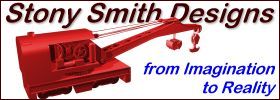Member Blogs
Suspension of disbelief (and the baseball industry layout)
For the TL;DR - just scroll down an look at photos is useful since it's about architecture :) Feedback appreciated !
I want my layout to have a high level of what's called suspension of disbelief. Context and texture can't be altogether forgotten forever. Light, sound, sense, feel, can't really put my finger on it sort of senses should abound. If you're already feeling engrossed while doing something that occupies your attention, and forgotten about the world, then you know what I mean. It's sorta like a form of escapism. I don't feel good or bad when I see an actor die in a movie after I see it - they're an actor. But I might have felt bad or good for the character during the film.
It's a frequently used term. Coming from an architectural background, my use of the term might be different than yours. I'm usually referring to issues specific to materials used in making models, not the "real thing" when using that term. Think about making realistic z-scale spring grasses, beaches, or asphaltic shingles - that's how I usually think of the term. Similar to the french "Trompe L'Oriel", translates as "Fool the eye". When I am talking about it and the subject isn't a model, it's often in reference to cognitive behavior or psychology such as how Disney uses many varying scale bricks, windows, doors, and tiles on Main Street to make it seem so much bigger than it really is. This form of deception or fooling the brain with the eyes with techniques like large-scale and multi-scale model building is common and normally used in a good way, even being very important for entire artistic movements like op-art or psychedelia. I've heard the term in meetings with architect, interior designers, video game developers, animators, cinematographers, and recently with some advertisers on Madison Ave. As might be expected for the cynic, the latter were not using it in a positive sense.
We're just modeling perception. THE rule applies: have fun to win, exceed expectation to win over others. With models, the physical scale rule applies (what works at full scale may or may not at model scale and vise versa, model techniques usually don't scale very well to full size).
Why Z (1:220) scale for me? Because it's closest to, but larger than my favorite scale for building models (1:240 or 1" = 20'-0"). Also, I live in an apartment where space is always a premium for "permanent layouts" - to the point where Z scale is cheaper than N, except for shelf layouts. Since I have scratch building skills (and materials still lying around) and no preference towards any particular road name or era, the choice for me was easy. It will be my model first designed for moving parts - and also implying my first without a single pre-controlled point of focus.
For my first real layout, I wanted to compose a list of baseball-related and other generic buildings (with a great tip for adding the Hollywood Candy Co. which I've just begun researching).
1. The pencil factory
Yes, pencils were made here! A classic NY building well known for tile work and architectural designs on the tops of the columns and pediments. I believe this building is becoming an historic site. The fascade is iconoclastic, and this sort of factory building is slowly being removed from urban areas. It did not have direct access to rail service. This factory is close to the water, and served with ships docked at the piers at Greenpoint. Also, it's an abandoned factory and thanks to architectural irony in stereotypical NY fashion, it has been overrun by artists and in the process of being transformed into lofts - priced at a premium for that neighborhood - no doorman included, yet.
The pencil factory, Brooklyn NY
http://www.fliffa.com/indexcontact.html
2. The Louisville Slugger factory
Classic brick architecture, crass modern advertising (hiding the glass anti-contextual architectural extension behind it). Cast iron storefront on a standard double-width factory building from that time. All pretty boring architectural massing and borg details really, including the arch-toped windows on the top floor. It's hard to see the pediment since it's in shadow of the photo, but I would assume it's just as uninspiring as the rest of the building. Hopefully there'd be some cool imagery architrave-like such as some player in stamped tin sliding for home, but I doubt it. Even the set-back modern two story black and glass extension is genericly de-emphasized... this building is all about the bat. It definitely can stand on its own, or stand out by contrasting it to small one and two story buildings. Proof that the prototype can be better than the freelance, without any complexity added (ok, maybe finding a real keychain-sized slugger and doing the scale fencing might be hard).

The Louisville Slugger Factory, Louisville, KY
http://www.sluggermuseum.com/virtualtour/#big_bat
3. The Baseball hall of fame
One part Italian villa, one part Jeffersonian gallery, and one part brick city with factory-like floor to floor heights, this classic configuration of building is pleasing and subdued. Upper windows to allow in light contrasting with nearly solid brick lower with classic wood detailing in the frieze and soffit of this building catch the eye. The entry doors dominate the street front elevation, while not quite as open you would expect an public building such as the MLB Hall of Fame to be, it is still inviting with the semi-public space between the buildings.
The dreams park is nearby - a gem of very small scenes and structures for parks and green spaces (url below, the subject deserves it's own blog post... Mr. T coaching little league batting practice is just a hint).

The symmetric wings of the building are always visible in photographs while other parts are usually cropped.
http://baseballhall.org/museum/experience/museum http://www.baseballmomologues.com/?p=280
4. Hollywood candy factory
I will continue looking, and also checking out factories along the Centralia rail lines - which I just started learning about yesterday. However, finding a picture of the specific building became totally irrelevant after I read this on wikipedia:
"During the 1950s, the Hollywood Candy Company owned a Crosley Super Sport which was painted to look like the Zero candy bar wrapper and employed a midget, called Zero, to drive around and advertise the candy bar"
Even with an igloo factory, this proves the prototype is superior to freelance. You can't make up stuff like that. Comedy gold.

http://en.wikipedia.org/wiki/Hollywood_Candy_Company
Do not build one of these unless you need a temporary placeholder
For an example of the opposite, get into the google street view and check out Rawlings (bats and gloves) corporate HQ. I refuse to link it for you. It's 110% suburban office park lowrise mirror glass ugly. A wasteland of architectural potential and space, at best. If you need to add THE suburban office park building to your model, grab a mirror and a sharpie then draw a grid with the ruler. Just use the ruler, both sides in each direction for the grid. You can get creative and measure if you want - and end up with a non-square rectangular grid, but that ruins the design intent of the THE suburban office park building. Bevel the edges of the mirror, then finish by planting the tributary green pingpong ball on a soda straw or toothpick near the entrance to the oversized parking lot. Note that applying the scale rule to models means this might work if scale building mirror glass is tinted, especially if it's real and from a broken shard leftover from one of these monstrosities. Tinted-mirrored acrylic 1/8" thick is also available for purchase in 3" squares from canal plastics for about $2 if you want to try it out.
Any more non-stadium buildings?



















